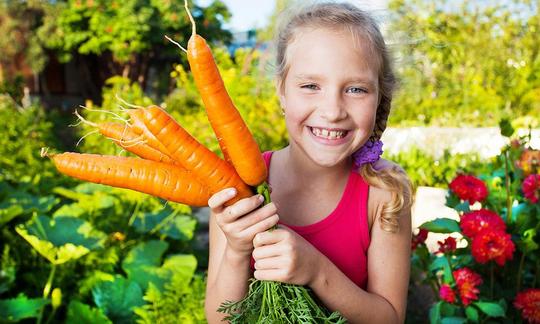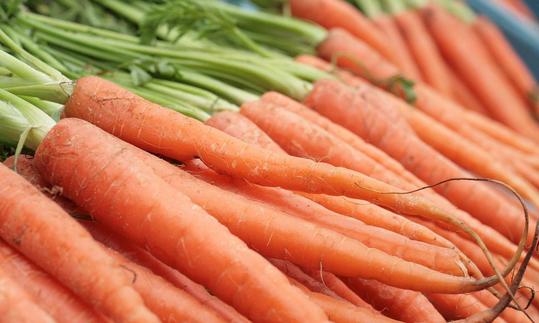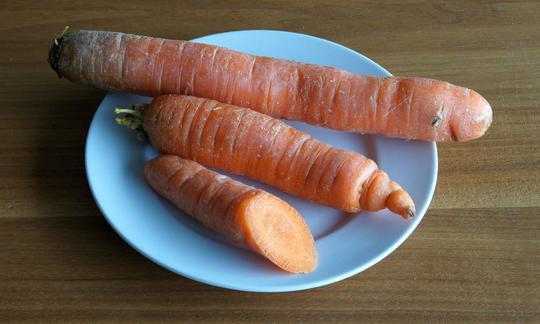Table of contents
The carrot, also called carrot or turnip ( Daucus carota subsp. sativus) is a popular low-calorie raw food and is known for its high carotene content.
Using carrots in the kitchen:
In the kitchen, the carrot root is mostly used. The fresh carrot leaves can be used for smoothies or pesto.
Can you eat carrots raw? Carrots (raw) can be used in many different ways. Fresh carrots (organic) are a popular raw food snack in combination with tomatoes, kohlrabi, cucumbers, bell peppers for dips or hummus. Sliced or grated, raw carrots go well with any leaf salad, such as romaine, iceberg,head or Batavia lettuce.
When cooked, they give dishes a sweet aftertaste. They go well in soups ( chestnut and carrot soup with garam masala) or in a gratin ( carrot gratin with fresh herbs). Together with mung beans and pointed peppers, they make a great side dish for rice. They can also be used for raw food spreads, vegan relish or chutney.
The sweet carrots are ideal for desserts. They can be used in cakes (carrot cake) or to make carrot jam. The vegetable is also popular as a puree for introducing solid foods to small children.
Vegan recipe for carrot, apple and avocado salad:
Ingredients (for 4 people): 700 g carrots, 2 apples, 2 avocados, 6 tbsp lemon juice, 1 tbsp agave syrup,black pepper, 6 tbsp mixed kernels and seeds ( pumpkin, sunflower or linseed), 1 handful of garden cress.
Preparation: Wash and clean the carrots, then grate them. Wash the apple and cut into bite-sized pieces. Halve the avocado, remove the stone and remove the flesh from the skin. Cut the flesh into small pieces. Mix the apple and avocado pieces with 1-2 tablespoons of lemon juice. Mix the remaining lemon juice with agave syrup and season with pepper. Mix the carrots with the dressing and then add to the apple and avocado mixture. Sprinkle the salad with seeds and cress and serve.
Vegan recipes with carrots can be found under the note: " Recipes that have the most of this ingredient ".
| Not only vegans or vegetarians should read this: Vegans often eat unhealthily. Avoidable nutritional errors. |
Shopping - where to buy carrots?
Carrots are often available in large supermarket chains such as Coop, Migros, Denner, Volg, Spar, Aldi, Lidl, Billa, Rewe, Edeka or Hofer. Carrots can also often be bought in organic supermarkets such as Denn's Biomarkt or Alnatura. Carrots are harvested outdoors from June to October. 4
The availability of carrots in the supermarkets mentioned varies depending on the size of the store, catchment area, etc. If you are interested, click on our recorded food prices for the DA-CH countries (above under the ingredient image). There you will find current prices from various supermarkets and their price development.
Found in the wild:
A wild relative of the cultivated carrot ( Daucus carota subsp. sativus) is the wild carrot ( Daucus carota subsp. carota), which is native to Central Europe, northern Africa and Turkey. 9 It can be found in dry meadows, in quarries, on roadsides and on embankments. The young leaves, stems and white root can be eaten. 10 It can be confused with the poisonous fool's parsley or hemlock. An important identifying feature is the smell. The wild carrot gives off a pleasant spicy to carrot-like scent. In the middle of the white umbel flowers there is usually a blackish false flower that is supposed to attract insects. 10
Storage:
It is best to store the carrots unwashed and without the leaves, wrapped in a damp tea towel in the vegetable compartment of the refrigerator. 6 This way they will keep for at least a week. 5 There should be no apples, pears or tomatoes next to them, as the ripening gas they give off makes the carrots bitter and causes them to spoil more quickly. 6 In the cellar they can be stored unwashed in damp sand or in another cool, frost-free place with high humidity over the winter. 7
Ingredients - Carrot Nutritional Values - Calories:
Raw carrots (organic) contain 41 kcal per 100 g and are therefore low in calories. The protein content is low at 0.93 g/100g and there is also hardly any fat at 0.24 g/100g.
Do carrots contain carbohydrates? They contain 9.6 g/100 g of carbohydrates, of which 4.7 g is sugar. The fiber content is 2.8 g/100 g. Carrots also contain 175 mg/100 g of salt, which is 7.3% of the daily requirement. 1
Carrots are known for their high content of vitamin A, known as RAE. This is present as provitamin A in the form of carotenoids. 100 g of carrots contain 835 μg, which covers 104% of the daily requirement. Carrot juice (956 μg), sweet potatoes (709 μg) and dried chili peppers (1324 μg) are also rich in vitamin A. Dried goji berries also contain a lot of vitamin A (1341 μg). Sweet paprika powder (6042 μg), hot paprika powder (2463 μg) and chili powder (1483) contain a lot of provitamin A, but people usually only eat 1 g of it, which is why the content per portion is small. 1
The essential amino acid threonine is also present. 100 g of carrots contain 0.19 g of threonine, which covers 21% of the daily requirement. Green peas (20 g), white short grain rice (23 g) and jasmine rice (26 g) have a similar content. Spirulina (3.0 g) and brewer's yeast (2.7 g) contain a lot of threonine. 1
The vitamin K content is 13 μg/100g. This covers 18% of the daily requirement of vitamin K1. Sauerkraut and pickled jalapeños have the same value. Raw kale (705 μg/100g) and chard (830 μg/100g) have very high vitamin K values. This corresponds to 940% and 1107% of the recommended daily dose. 1 The absorption rate is 20 - 70% (absorption rate of the vitamin in the body). Toxic properties of vitamin K from food are not known. 2
The complete ingredients of carrots, the coverage of the daily requirement and comparison values with other ingredients can be found in our nutrient tables. In the article Nutrients explained you will get a detailed insight into the topic.
Dangers - Intolerances - Side effects:
Excessive consumption of carrots can lead to yellowing of the hands and face (carotenemia, carotenoderma). This is caused by the storage of beta-carotene or other carotenoids in the skin. It is reversible and disappears as soon as the consumption of carotenoids is reduced. 12
Carrots can cause an allergic reaction in some people, even when cooked. People who are allergic to birch pollen often develop a cross allergy. 11
Health aspects - effects:
Are carrots healthy? Carrots are rich in provitamin A in the form of carotenoids (around 16 to 38 mg/100g), of which around 80% is beta-carotene. The carotenoid content varies depending on the variety, with very orange carrots containing a lot of them. Vitamin A is important for the immune system and eyesight, among other things. 17
The bioavailability of carotenoids depends on factors influencing the food and how it is prepared and processed. The factors influencing the food itself are the subject of current research and cannot be influenced by the consumer. 13 On the other hand, the careful preparation of a food can noticeably increase the absorption of carotenoids. Factors such as adding fat, chopping or cooking increase their accessibility and thus their absorption. 16 Chopping plays the biggest role here. 13,16
Although fat increases carotenoid absorption in any case, it is much more efficient to break down the food very well (chew well, puree, etc.). As far as fat intake is concerned, natural fats such as nuts ( macadamia, walnuts, etc.) or avocado are sufficient. 13,15 You should avoid additional oil or even butter, as they do not achieve better results in terms of bioavailability and do more harm than good. Cooking helps to destabilize the cell walls and thus also contributes to availability, but at the same time destroys heat-sensitive ingredients such as many B vitamins or vitamin C. 13,14
Occurrence - Origin:
The exact origin of the carrot is unclear. Possible areas of origin are thought to be in northern Africa, the Middle East and southern Europe. 7 The cultivated carrot could be a cross between the wild carrot ( Daucus carota subsp. carota) and the giant carrot ( Daucus carota subsp. maximus). However, it is also possible that it originates from the black carrot ( Daucus carota subsp. afghanicus). 7 According to the FAO, the most important growing countries in 2020 are China, Uzbekistan, the USA, Russia, Ukraine and Germany. 8
Growing in the garden or as a potted plant:
Carrots are easy to grow in the garden or raised bed. Carrots even thrive in pots or balcony boxes if they are 30 to 40 cm deep. Carrots prefer loose, permeable and slightly sandy loam soil. The pH value should be between 5.5 and 6. If the soil is too compacted or stony, carrots tend to form several "legs". The location should be as sunny and exposed to wind as possible so that the carrots are less affected by diseases and pests. 3 Sowing takes place between March and mid-July. To do this, place the seeds in 2-3 cm deep furrows. It is important to leave a distance of 3-5 cm between the plants so that the carrots have enough space to grow. It is best to sow them in rows, with the distance between them being 30 to 40 cm. Cover the furrows with soil, press down lightly and water. 3
Cultivation - Harvest:
Very early-ripening varieties require around 80 to 90 days from sowing to harvest, while late-ripening, well-storable carrots require 140 to 190 days. 3 The harvest period for carrots is from June to October. 4 After harvesting, the carrot tops should be removed so that the carrots stay crisp and fresh for longer. 4
Carrots from conventional farming are sometimes contaminated with pesticides. That is why organically grown carrots should be preferred.
General information:
The carrot ( Daucus carota subsp. sativus) belongs to the family Apiaceae and is closely related to parsnip ( Pastinaca sativa), root parsley ( Petroselinum crispum) and celery ( Apium graveolens). 7
Alternative names:
Carrots are also known as carrots, turnips, yellow turnips and in Switzerland as Rübli.
Literature - Sources:
Bibliography - 17 Sources (Link to the evidence)
| 1. | USDA United States Department of Agriculture. |
| 2. | Biesalski H K, Grimm P. Taschenatlas der Ernährung. Stuttgart: Georg Thieme Verlag; 2015, 6. Auflage. |
| 3. | Plantura.garden. Karotten pflanzen: Aussaat, gute Nachbarn & Pflege. |
| 4. | Plantura.garden. Karotte ernten, lagern & haltbar machen. |
| 5. | Bundeszentrum für Ernährung. Lebensmittellagerung im Haushalt (pdf). |
| 6. | Alnatura.de. Möhren: Haltbarkeit und Aufbewahrung. |
| 7. | Plantura.garden. Karotte: Herkunft, Wachstum & Vermehrung. |
| 8. | FAOSTAT Food and Agriculture Organization of the United Nations. Carrots and turnips. 2020. |
| 9. | Kräuterbuch.de. Wilde Möhre. |
| 10. | Bundesamt für Ernährung. Die Wilde Möhre in der Küche. |
| 11. | Jacob T et al. Food Processing Does Not Abolish the Allergenicity of the Carrot Allergen Dau c 1: Influence of pH, Temperature, and the Food Matrix. Mol Nutr Food Res. 2020 Sep;64(18): e2000334. |
| 12. | Maharshak N, Shapiro J, Trau H. Carotenoderma. A review of the current literature. Int J Dermatol. 2003 Mar;42(3): 178-81. |
| 13. | Priyadarshani AM. A review on factors influencing bioaccessibility and bioefficacy of carotenoids. Crit Rev Food Sci Nutr. 2017 May 24;57(8): 1710-1717. |
| 14. | Castenmiller JJ, West CE. Bioavailability and bioconversion of carotenoids. Annu Rev Nutr. 1998;18: 19-38. |
| 15. | Unlu NZ, Bohn T, Clinton SK, Schwartz SJ. Carotenoid absorption from salad and salsa by humans is enhanced by the addition of avocado or avocado oil. J Nutr. 2005 Mar;135(3): 431-6. |
| 16. | Hedrén E, Diaz V, Svanberg U. Estimation of carotenoid accessibility from carrots determined by an in vitro digestion method. Eur J Clin Nutr. 2002 May;56(5):425-30. |
| 17. | Ahmad T et al. Phytochemicals in Daucus carota and Their Health Benefits-Review Article. Foods. 2019 Sep 19;8(9): 424. |















Comments